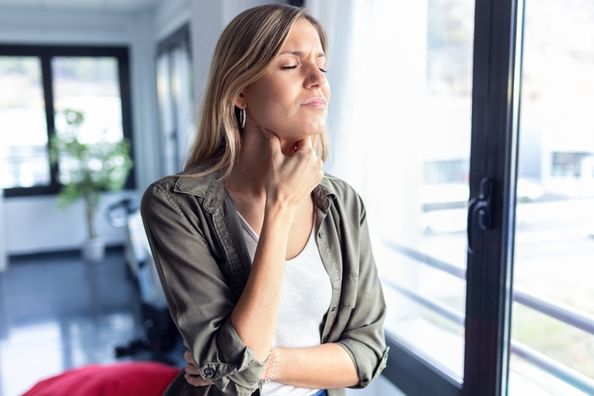An estimated 53,000 people are diagnosed with mouth or throat cancers each year in the United States. These cancers can be found on your gums, lips, salivary glands, tongue, tonsils and other parts of your mouth and throat. Traditionally, these cancers are more likely to occur in men, typically over the age of 55, and have been primarily linked to tobacco and alcohol use. While the overall rate of mouth and throat cancer cases is declining, the rate of throat cancer cases diagnosed in younger adults and linked to HPV infection are on the rise.
As with any type of cancer, it is important to be aware of common symptoms and to understand your individual risk. You may be at an increased risk of developing mouth or throat cancer if one (or more) of the following apply to you.
Common Causes of Mouth and Throat Cancers
Tobacco use
The majority of people with mouth or throat cancers use, or have used, tobacco. Your risk increases the longer and more frequently you use tobacco. In addition to cigarettes, other tobacco products can cause cancer. If you use a pipe, your risk is very high to develop cancer of the lips, particularly in areas that come into contact with the pipe. Oral tobacco products, like chews or dips, are linked to cancers of the cheeks, gums and lips.
Alcohol consumption
Frequent or excessive alcohol consumption increases your risk of developing mouth or throat cancer. In fact, an estimated 70 percent of patients diagnosed with oral cancers are heavy drinkers.
If you smoke and drink, your risk is even higher. If you use tobacco products, take steps to quit. Alcohol consumption should be limited to one drink per day for women and no more than two drinks per day for men.
Age
Oral cancers can occur at any age, but until recently, they were uncommon before the age of 55 because they often take several years to develop. This is changing as HPV-related cancers continue to become more common and tobacco use declines.
Gender
Men are almost twice as likely as women to develop mouth and throat cancers. This gender gap may begin to shrink if HPV-related cases continue to increase.
HPV infection
HPV is a group of more than 150 different viruses, each assigned a unique number. Certain strands of HPV have been linked to oral and reproductive cancers, however HPV16 is the virus subtype most often associated with mouth and throat cancers. The number of throat cancers linked to HPV16 has increased significantly over the last several years, especially in young adults. The exact reason for this increase is still being researched, but it is thought to be related to cultural shifts in sexual behaviors, including more sexual partners, unprotected sex and increased frequency of oral sex. Vaccinations against HPV infections are available and your primary care provider can help you determine if an HPV vaccine is right for you. You can also reduce your risk by practicing safe sex.
Oral health
The health of your mouth, teeth and gums may also play a role in your overall risk. Poor oral hygiene can disrupt the balance of healthy bacteria found in your mouth and may cause a variety of issues including tooth loss, gum disease and cancer.
Ultraviolet light exposure
Ultraviolet (UV) light exposure, including sunlight, can increase your risk of developing cancers of the lips. If you spend a lot of time outdoors, it is important that you take precautions to limit your UV exposure. Proper precautions include avoiding time outside during the middle of the day when the sun’s UV rays are the strongest, wearing a wide-brimmed hat and frequently applying sunscreen and lip balms that contain a sun protection factor (SPF) of 30 or higher.
Symptoms of Mouth and Throat Cancer
It is possible to develop mouth or throat cancer without exposure to any of these risk factors. If you experience any of the following symptoms for more than two weeks, you should make an appointment with your primary care physician to determine the cause:
- Mouth pain or a sore that doesn’t heal
- A red or white patch or lump that forms on your cheeks, gums, tongue or tonsils
- A persistent sore throat or cough
- An irritation in your throat or sensation that something is caught in your throat
- Difficulty swallowing or chewing
- Vocal changes
- Bad breath
In many cases, the first symptom is not in your mouth or throat, but in your neck. If you discover a lump in your neck when you are not feeling sick, or if the lump does not go away after a few weeks, you should see your primary care physician.
Your doctor will review your symptoms, along with your medical and family history, and complete a physical exam to check for abnormalities on your face, head, neck and mouth. If further exams or testing is needed, your doctor may refer you to an ear, nose and throat specialist, or otolaryngologist.
If cancer is suspected, a small tissue sample called a biopsy will be taken to confirm the diagnosis and test for HPV infection. Biopsies provide your doctor with important information about how far the cancer has progressed and help guide treatment decisions.
There are currently no routine screening tests available for mouth and throat cancers. You can use a mirror to check the inside of your mouth for any lumps, patches or sores that may have formed. Oral cancers may also be found during routine dental exams, so it is important to get regular cleanings and maintain good oral hygiene.
Schedule an appointment with a primary care provider to discuss your risk factors and preventive steps you can take to reduce your risk for mouth and throat cancer.
Health Topics:







